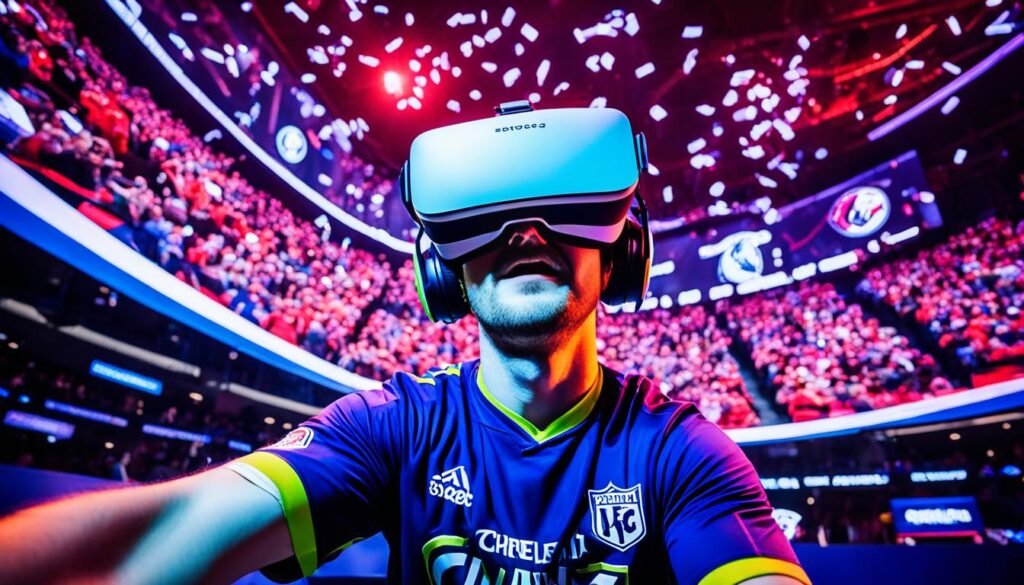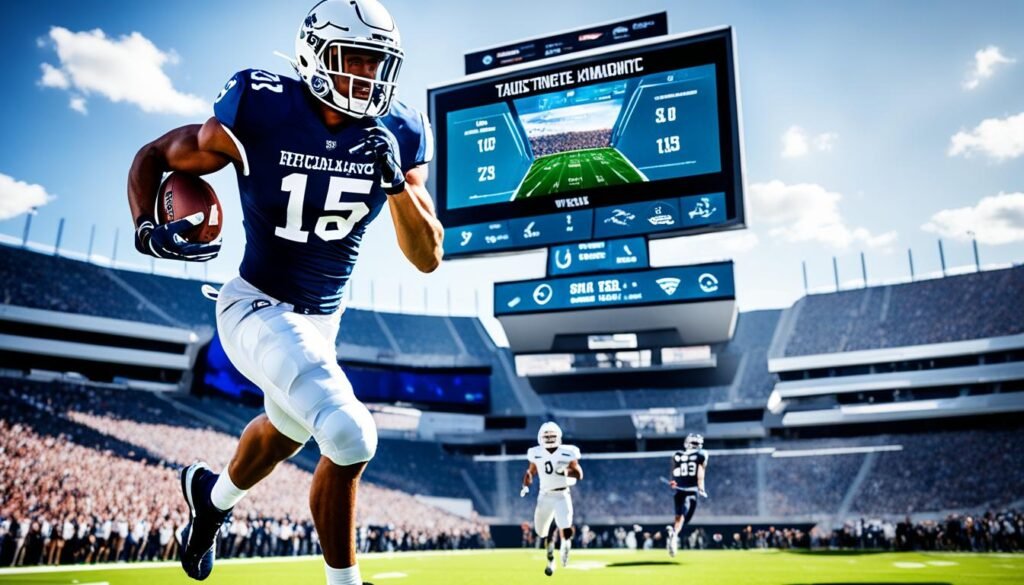The field of sports technology has experienced a revolution, transforming the way athletes perform, fans engage, and teams strategize. The advancements in wearable sports technology, smart sports equipment, and sports analytics technology have paved the way for cutting-edge sports performance technology and innovation in the field of sports science. This article will explore the various ways in which sports technology is revolutionizing the game.
Key Takeaways:
- Wearable sports technology, smart sports equipment, and sports analytics technology are driving advancements in the field.
- The sports technology industry offers various career opportunities, from data analysis to app development.
- Technology has significantly improved athlete safety through wearable technologies and injury prevention measures.
- Fans are enjoying enhanced engagement through streaming services, virtual reality, and real-time analytics.
- AI is playing a major role in sports strategy, providing data-driven insights and predictive analytics.
Top Jobs in Sports Technology
The rapidly growing sports technology industry offers numerous career opportunities in various fields. Whether you are passionate about data analysis, engineering, software development, or research, there’s a role for you in sports technology. Let’s explore some of the top jobs in the industry:
Sports Data Analyst
A sports data analyst plays a vital role in analyzing player performance, game outcomes, and statistical trends. By collecting and interpreting data, they provide valuable insights that help teams make informed decisions and improve their strategies.
Sports Biomechanist
A sports biomechanist focuses on understanding the mechanics of human movement in sports. They use advanced technologies to analyze biomechanical data and provide recommendations on how to optimize an athlete’s performance and reduce the risk of injury.
Also Read: Exploring the Latest in Automotive Technology Trends
Virtual Reality Sports Developer
Virtual reality sports developers create immersive training simulations and virtual experiences for athletes. These professionals leverage cutting-edge technology to design realistic environments that enhance training, strategy development, and game preparation.
Sports App Developer
Sports app developers are responsible for creating applications that enhance the fan experience. They design and develop user-friendly, feature-rich apps that provide real-time updates, live streaming, interactive content, and social media integration, allowing fans to engage with their favorite sports and teams seamlessly.
Esports Manager
With the rise of esports, the demand for esports managers has increased significantly. These professionals oversee the operations and strategy of esports teams, coordinating player development, tournament participation, and sponsorship opportunities in the fast-paced world of competitive gaming.
Sports Science Researcher
Sports science researchers conduct studies and experiments to advance our understanding of athlete performance and optimize training methods. They explore topics such as nutrition, sports psychology, recovery techniques, and injury prevention, contributing to the development of evidence-based practices in sports.
Sports Data Privacy Specialist
As the collection and utilization of sports data increase, ensuring data privacy becomes crucial. Sports data privacy specialists are responsible for developing strategies and protocols to protect sensitive information, ensuring compliance with privacy regulations and maintaining the trust of athletes, fans, and organizations.
Also Read: Boosting Life with Computer Technology Innovations
Stadium Technology Manager
Stadium technology managers oversee the implementation and maintenance of technology infrastructure within stadiums and arenas. They ensure that venues are equipped with state-of-the-art systems for audiovisual displays, wireless connectivity, and fan engagement, providing an unparalleled experience for spectators.
Sports Sustainability Coordinator
Sports sustainability coordinators focus on integrating environmentally friendly practices into sporting events and facilities. They develop initiatives to reduce waste, optimize energy consumption, and promote sustainability, harnessing the power of sports to inspire positive change and environmental stewardship.
These are just a few examples of the exciting career paths available in the sports technology industry. Whether you have a passion for data, engineering, development, research, or management, there’s a role that combines your skills and interests with the ever-evolving world of sports technology.
Stay tuned for the next section as we explore the impact of sports technology on athlete safety.
Sports Technology and Athlete Safety
The advancements in sports technology have not only revolutionized the way athletes perform but also prioritized their safety. Wearable technology has played a crucial role in enhancing athlete safety, allowing teams to monitor their health and performance in real-time. One such example is the use of GPS vests, which enable coaches and trainers to track athletes’ movements, heart rate, and exertion levels.
These GPS vests not only help optimize performance but also significantly reduce the risk of injuries by providing valuable insights into an athlete’s workload and recovery capabilities.
Also Read: Harnessing Business Technology for Growth
Additionally, helmet sensors have emerged as a game-changer in sports like cricket, where head injuries can have severe consequences. These sensors provide real-time impact analysis, allowing teams and medical staff to quickly detect and assess potential head injuries. Immediate intervention can then be provided, potentially preventing further harm.
The integration of wearable technology, such as GPS vests and helmet sensors, has elevated athlete safety standards and changed the perception of risk in sports.
By leveraging these technological innovations, athletes and teams can make informed decisions to prevent injuries and minimize the impact of accidents. Furthermore, the availability of accurate data allows medical professionals to design personalized injury prevention strategies and rehabilitation programs.
| Benefits of Sports Technology in Athlete Safety | |
|---|---|
| Real-time monitoring of athlete performance and health | |
| Early detection of potential injuries | |
| Optimization of training and recovery strategies | |
| Enhanced medical intervention and rehabilitation |
The integration of wearable technology, such as GPS vests and helmet sensors, has transformed athlete safety. These technological advancements have not only minimized the risk of injuries but have also paved the way for data-driven injury prevention and performance optimization strategies.
Also Read: Exploring Trends in Future Finance & Investment

Enhancing Fan Engagement through Technology
Technology has revolutionized the way fans engage with sports, offering exciting opportunities for immersive experiences and real-time interaction. With the rise of streaming services, virtual reality, and augmented reality, sports enthusiasts can now enjoy games and events like never before.
“Technology has transformed the fan experience, making it more accessible and interactive.”
Streaming services like ESPN+ and Amazon Prime have played a pivotal role in expanding access to sports content. Fans can now watch their favorite games and events from anywhere, at any time. Whether it’s catching up on missed matches or staying up-to-date with live games, streaming services have truly transformed the fan experience.
But it doesn’t stop there. Virtual reality (VR) and augmented reality (AR) technologies have taken fan engagement to new heights. VR allows fans to feel like they are right in the stadium, offering a 360-degree view of the action. They can virtually attend games, stand on the sidelines, and immerse themselves in the atmosphere. On the other hand, AR enhances the live viewing experience by overlaying real-time analytics and stats on the screen, providing fans with instant insights and analysis.
Also Read: BMW Finance Options – Get Your Dream Car Now!

The incorporation of real-time analytics has also added a new level of excitement for fans. By having access to live data, such as player stats, scores, and performance analysis, fans can engage in informed discussions and debates with fellow supporters. This real-time information brings fans closer to the game, enhancing their understanding and enjoyment of the sport.
For instance, imagine watching a basketball game where you can see the shooting percentages of each player in real-time, or a soccer match where you can analyze the distance covered by individual players. These real-time analytics create a more interactive and engaging experience for fans.
Benefits of Enhancing Fan Engagement
Enhancing fan engagement through technology brings several benefits to both fans and sports organizations. It fosters a stronger sense of community among fans, allowing them to connect, share experiences, and support their teams. With the power of social media and online communities, fans can discuss games, share highlights, and even participate in virtual watch parties.
Furthermore, increased fan engagement leads to higher fan loyalty and ultimately drives revenue for sports organizations. When fans feel more connected and involved with their favorite teams, they are more likely to attend games, purchase merchandise, and support sponsors.
Summary Table: Enhancing Fan Engagement through Technology
| Technology | Benefits |
|---|---|
| Streaming Services | Increased accessibility to sports content |
| Virtual Reality | Immersive experiences and virtual game attendance |
| Augmented Reality | Real-time analytics and stats overlay |
| Real-Time Analytics | Enhanced understanding and engagement with the game |
| Community Building | Stronger fan connections and support for teams |
As technology continues to advance, we can expect even more innovations that will bring fans closer to the sports they love. The future holds the promise of enhanced interactivity, personalized experiences, and further integration of real-time analytics. Fan engagement through technology is shaping the way we consume sports and creating a more interactive and inclusive fan culture.
The Impact of AI in Sports Strategy
The integration of artificial intelligence (AI) in sports strategy has revolutionized the way teams analyze and make decisions. Major League Baseball and Rugby are among the sports that have embraced AI technology for game analysis and performance evaluation. Leveraging AI-driven insights, teams have transitioned from traditional scouting methods to a more data-driven and analytical approach.
AI-powered predictive analytics play a significant role in strategic decision-making, enabling teams to forecast player performance and game outcomes. By leveraging data-driven insights, teams can make strategic decisions that enhance their performance and lead to more dynamic games. The use of AI in sports strategy has opened up new possibilities for teams to gain a competitive edge and optimize their game plans.
“AI is transforming the way we approach sports strategy. It allows us to analyze vast amounts of data and gain valuable insights into player performance, opponent tendencies, and game dynamics. This enables us to make more informed decisions and develop winning game plans.”
Performance analysis is another area where AI has made a significant impact. Through advanced algorithms and machine learning, AI technologies can analyze player movements, techniques, and patterns, providing valuable insights to improve training sessions and optimize performance on the field.
The use of AI in sports strategy is not limited to professional teams. College and amateur teams are also leveraging AI technologies to gain a competitive advantage and improve their game strategies. The integration of AI-driven insights in sports strategy has elevated the overall level of gameplay and transformed the way teams analyze and approach their opponents.
Benefits of AI in Sports Strategy:
- Access to data-driven insights for more informed decision-making
- Predictive analytics for forecasting player performance and game outcomes
- Enhanced game analysis for strategic planning
- Improved performance analysis to optimize training and player development
By harnessing the power of AI, teams can unlock a wealth of data-driven insights and make more strategic decisions. The integration of AI in sports strategy brings a new level of sophistication and competitiveness to the game, allowing teams to leverage cutting-edge technology to gain a competitive edge.

Image caption: AI technologies are transforming the way teams approach sports strategy, providing data-driven insights and improving performance analysis.
The Future of Sports Technology
The future of sports technology holds exciting advancements that will reshape the sports landscape. Emerging trends such as 5G and the Internet of Things (IoT) will revolutionize the way athletes train, compete, and engage with fans.

One of the key developments that will shape the future of sports technology is the widespread adoption of 5G. This ultra-fast wireless technology will enable real-time data transmission and faster communication between devices. With 5G, athletes and teams will have access to seamless connectivity, enabling them to make split-second decisions based on real-time data and analysis.
The Internet of Things (IoT) will also play a significant role in the future of sports technology. With IoT-enabled sensors embedded in sports equipment, athletes’ performance data can be captured and analyzed in real-time. These sensors will provide valuable insights into various aspects of the game, including speed, acceleration, heart rate, and positioning. Coaches and trainers can use this data to optimize training programs, tailor strategies, and prevent injuries.
Another key aspect of the future of sports technology is the integration of AI-driven strategies. Artificial intelligence algorithms can analyze vast amounts of data and provide valuable insights for training, game analysis, and strategic decision-making. AI can identify patterns and trends that humans might miss, giving athletes and teams a competitive edge.
| Advancements in Sports Technology | Impact |
|---|---|
| 5G | Ultra-fast communication and real-time data transmission. |
| Internet of Things (IoT) | Real-time performance data and injury prevention. |
| AI-driven strategies | Data-driven insights and strategic decision-making. |
The future of sports technology holds immense potential for athletes, teams, and fans alike. The integration of 5G, IoT, and AI-driven strategies will unlock new possibilities, enabling athletes to push their limits, teams to optimize performance, and fans to have immersive and interactive experiences.
Career Opportunities in Sports Technology
The field of sports technology offers numerous career opportunities, with diverse roles available within the sports technology industry. Whether you have a passion for data analysis, engineering, app development, or marketing, there’s a place for you in this exciting field. As sports technology continues to evolve, professionals with the right skills and knowledge are in high demand.
If you are looking to embark on a career in sports technology, there are various educational paths you can take to enhance your expertise and increase your chances of success. Sports technology courses and certificate programs provide valuable training and insights into the latest advancements in the industry, equipping you with the skills needed to excel in your chosen field.
To give you a better understanding of the career opportunities in sports technology, here are some potential roles that you can explore:
| Role | Description |
|---|---|
| Sports Data Analyst | Collect and analyze sports data to provide valuable insights for teams, coaches, and athletes. Drive data-driven decision-making and strategic planning. |
| Sports Technology Engineer | Design and develop innovative sports equipment and technologies to enhance athlete performance and improve the overall sports experience. |
| Sports App Developer | Create mobile applications that provide an immersive and interactive sports experience for fans, incorporating features such as live streaming, real-time updates, and social engagement. |
| Sports Marketing Specialist | Plan and execute marketing campaigns to promote sports technology brands and products, leveraging digital platforms, social media, and partnerships. |
| Sports Technology Consultant | Advise sports organizations on the implementation and utilization of sports technology solutions, offering strategic guidance and expertise. |
These are just a few examples of the exciting career paths available in sports technology. As the industry continues to grow and innovate, new opportunities will emerge, enabling professionals to make their mark in this dynamic field.
If you’re passionate about sports and technology, pursuing a career in sports technology can be a rewarding choice. Whether you’re interested in working with professional teams, sports organizations, or technology startups focused on the sports industry, there are plenty of avenues to explore. So, seize the opportunity to be part of the sports technology revolution and shape the future of sports!
The Impact of Technology on Professional Leagues
Technology has revolutionized the world of professional sports leagues, transforming the way they operate, generate revenue, and engage with fans. From sports valuation to lucrative TV deals and an evolving sponsorship landscape, technology has played a pivotal role in shaping the growth and success of these leagues.
The valuation of major professional sports leagues, such as the NFL, NBA, and MLB, has experienced unprecedented growth over the last decade. In fact, the value of these leagues has outperformed stock indices, showcasing the immense financial impact of technology in the sports industry.
“The integration of technology has led to a significant increase in the valuation of professional sports leagues, positioning them as valuable assets for investors and stakeholders.” – Sports Valuation Analyst
One of the key drivers behind the increased valuation is the massive television deals signed by these leagues. Broadcasting rights have become a crucial revenue stream, with networks competing for exclusive access to live sports events. This shift to digital broadcasting has allowed leagues to reach a broader global audience and generate substantial income.
Furthermore, the sponsorship landscape in professional sports has transformed with the advent of technology. Brands are now leveraging digital platforms, social media, and data analytics to create targeted marketing campaigns that resonate with fans. This integration of technology has opened new avenues for sponsorships, contributing to the financial stability and growth of professional sports leagues.
The table below showcases a comparison of the valuation of various professional sports leagues:
| League | Valuation (in billions USD) |
|---|---|
| NFL | 107.7 |
| NBA | 75.1 |
| MLB | 49.2 |
| Premier League (English Football) | 48.7 |
| NHL | 22.4 |

With the continuous advancement of technology, professional sports leagues are expected to further expand their reach, innovate game experiences, and maximize revenue opportunities. As emerging technologies like virtual reality, augmented reality, and artificial intelligence continue to evolve, the possibilities for enhancing the fan experience and generating additional revenue streams are endless.
Stay tuned for the next section to explore the impact of technology in college athletics and its role in supporting student-athletes.
Technology in College Athletics
College athletics have witnessed a significant transformation with the integration of sports technology. This innovative approach aims to enhance the overall fan experience while providing support to student-athletes. One notable player in this field is On3 Sports, a company that has revolutionized the way fans, media, coaches, and athletes connect.

On3 Sports offers comprehensive platforms that serve as information hubs and engagement opportunities. Fans can stay up-to-date with the latest news, interact with their favorite athletes, and actively participate in discussions. Coaches and media professionals have access to valuable insights and data, aiding them in making informed decisions and providing in-depth analysis.
“On3 Sports has created a digital ecosystem that bridges the gap between college athletics stakeholders. It has revolutionized the way fans engage with their favorite teams and athletes while empowering student-athletes with advanced technology and resources.” – Sports Technology Magazine
In addition to enhancing fan engagement, technology plays a crucial role in college sports marketing and the development of a digital ecosystem that benefits athletes and brands. The emergence of Name, Image, and Likeness (NIL) regulations has further emphasized the importance of leveraging technology to create valuable marketing opportunities for student-athletes.
The Role of Technology in College Sports Marketing
- Enhancing fan interaction through social media campaigns and personalized content
- Creating digital platforms for athletes to build their personal brand and connect with sponsors
- Utilizing data analytics to identify target markets and optimize marketing strategies
- Implementing virtual reality experiences to give fans a unique perspective on game day and training sessions
- Facilitating seamless ticket purchasing and event promotions through mobile apps
By leveraging sports technology, colleges and universities can create a digital ecosystem that benefits all stakeholders involved. It not only enhances the fan experience but also provides student-athletes with invaluable opportunities to showcase their talent, build their personal brand, and establish connections within the sports industry.
The Transformation of Sports Media and Innovation
Sports media has undergone a remarkable transformation, driven by the integration of technology. With the advent of sports technology innovation and the utilization of advanced tools, the way sports are consumed and experienced has been revolutionized. From data visualization and interactive experiences to groundbreaking broadcasting techniques, technology has played a pivotal role in enhancing the overall sports media landscape.
Data Visualization: Unveiling Insights in a Visual Format
One of the key contributions of technology in sports media is data visualization. Through visually appealing charts, graphs, and infographics, complex sports data is transformed into easily understandable information. Data visualization enables sports enthusiasts to grasp the patterns, trends, and performance metrics that drive the game.
For example, using interactive visualizations, such as heat maps, fans can analyze players’ movements on the field, revealing strategic insights to better understand the game. Sports broadcasters can utilize augmented reality overlays to display real-time statistics and analytics, making the viewing experience more immersive and informative for fans.
Interactive Experiences: Engaging Users on a Personal Level
Interactive experiences have redefined the way fans engage with sports media. Technological advancements have given rise to virtual reality experiences and augmented reality applications that enable fans to interact with their favorite sports and athletes like never before.
Imagine being able to virtually step into a soccer stadium, with interactive controls to navigate and explore the environment. Or, using augmented reality, you can place yourself on the basketball court, playing alongside your favorite NBA player. These interactive experiences bring fans closer to the action, creating a sense of presence and excitement.
Innovative Broadcasting Techniques: Beyond Traditional Coverage
“Sports media has evolved from providing mere coverage to crafting immersive narratives that captivate audiences. Through technology, broadcasters can offer viewers a unique and personalized perspective, enhancing the overall sports-watching experience.”
Technology in sports media has opened doors to creative and innovative broadcasting techniques. From multiple camera angles and slow-motion replays to enhanced audio experiences, broadcasters can deliver captivating content that captivates and engages audiences.
Also Read : Exploring the Latest in Automotive Technology Trends
Additionally, live streaming platforms have gained significant popularity, enabling fans to watch sports events in real-time from anywhere in the world. Sports technology has paved the way for seamless streaming experiences, ensuring that fans never miss a moment of the action.

The Impact of Sports Technology on the Media Landscape
| Enhancements | Benefits |
|---|---|
| Data Visualization | Improved understanding of sports analytics and performance metrics |
| Interactive Experiences | Increased fan engagement and immersion in the sports world |
| Innovative Broadcasting Techniques | Enhanced viewer experience through personalized and immersive narratives |
From data visualization to interactive experiences and innovative broadcasting techniques, technology has paved the way for unprecedented advancements in sports media. As the sports technology industry continues to thrive, we can expect even more exciting developments that will reshape how we consume and engage with sports media in the future.
Conclusion
The revolution of sports technology has brought about a significant transformation in the world of sports. From wearable devices that enhance athlete performance to cutting-edge analytics technology that redefines the fan experience, sports technology has revolutionized the game in numerous ways.
With this revolution comes a wide range of exciting career opportunities in the field of sports technology. Professionals skilled in data analysis, engineering, app development, marketing, and innovation can explore diverse roles within this industry. As technology continues to advance, the future of sports technology holds immense potential for those seeking a career in this dynamic field.
As we look ahead, the future of sports technology promises even more groundbreaking advancements. Emerging trends like 5G and the Internet of Things (IoT) will further revolutionize the sports landscape, enabling real-time data collection through sensors embedded in sports equipment. Coupled with AI-driven strategies, these technological advancements will elevate sports performance and strategy to new heights.
In conclusion, the sports technology revolution has paved the way for unprecedented opportunities in both the present and the future. Whether you’re passionate about data analysis, engineering, app development, marketing, or innovation, the field of sports technology offers a wide range of career paths to explore. Embrace the limitless possibilities that technology brings and be part of shaping the future of sports.
FAQ
Q: How is sports technology revolutionizing the game?
A: Sports technology is revolutionizing the game by introducing new gadgets, such as wearable sensors and high-tech tracking devices, to help athletes improve their performance and stay ahead of the competition. It also enhances the fan experience through digital fan engagement.
Q: What is goal line technology and how does it work?
A: Goal line technology is a system used to determine whether a goal has been scored or not. It typically uses camera-based systems or sensors to track the ball and determine if it has crossed the goal line.
Q: How does instant replay benefit sports officials?
A: Instant replay systems help referees and officials make more accurate calls during games by providing visual evidence of crucial moments, like determining if a ball crossed the goal line or if a player committed a foul.
Q: What role does Hawk-Eye technology play in sports?
A: Hawk-Eye technology is commonly used in sports to track the ball’s trajectory and provide accurate, real-time data on its position. This technology helps in decision-making by sports officials and enhances the viewing experience for fans.
Q: How can sports technology improve athlete performance?
A: Sports technology, including biometric trackers and performance analysis tools, can help athletes track their training and performance metrics. This data allows them to adjust their training methods and improve their overall athletic performance.
Q: How are sports fans benefiting from the latest sports technology?
A: Sports fans are benefitting from the latest sports technology through enhanced viewing experiences, interactive fan engagement platforms, and access to real-time data and analytics during games.
Q: Can goal line technology also be used in determining other aspects of the game?
A: Yes, goal line technology can also be used to determine other game-related aspects, such as tracking the ball’s trajectory, predicting where the ball would have landed, and assisting referees in making crucial decisions during gameplay.
Q: What is goal line technology in sports?
A: Goal line technology is a system used to determine whether a ball has crossed the goal line, typically aiding referees in making accurate decisions during matches.
Q: How has instant replay revolutionized sports?
A: Instant replay allows officials to review key moments in games to make more informed decisions, enhance fairness, and reduce human error in sports.
Q: What is the role of wearable sports technology in enhancing athlete performance?
A: Wearable sports technology such as biometric trackers can help athletes track their performance metrics, adjust their training, and improve overall performance.
Q: How does goal line technology help referees in soccer matches?
A: Goal line technology in soccer enables referees to determine with accuracy whether the ball crossed the goal line, helping them make crucial decisions during matches.
Q: How is sports management being transformed by the latest sports technologies?
A: Sports management is evolving with the integration of new technologies such as player tracking systems, performance analytics, and digital fan engagement platforms.
Q: What is the significance of hawk-eye technology in various sports?
A: Hawk-eye technology is used for accurate ball tracking in sports like tennis and cricket, helping players, coaches, and officials make informed decisions based on trajectory data.
Q: How are sports teams utilizing sensor technology to stay ahead of the competition?
A: Sports teams are incorporating sensor technology to monitor player performance, optimize training routines, and gain insights that can give them a competitive edge in their respective sports.
Source Links
- https://rallypoint.pr/revolutionizing-the-game-how-technology-is-changing-the-sports-industry/
- https://www.linkedin.com/pulse/changing-game-how-technology-revolutionizing-sports-across-jon-flynn-yi13c
- https://www.yellowbrick.co/blog/sports/revolutionizing-the-game-how-sports-technology-is-transforming-athletics






